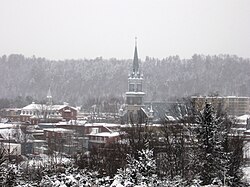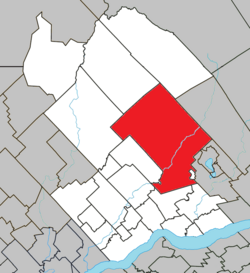Saint-Raymond, Quebec
| Saint-Raymond | |||
|---|---|---|---|
| City | |||
 |
|||
|
|||
| Nickname(s): Automobile City | |||
| Motto: Pax in veritate (Peace in truth) | |||
 Location within Portneuf RCM. |
|||
| Location in central Quebec. | |||
| Coordinates: 46°54′N 71°50′W / 46.900°N 71.833°WCoordinates: 46°54′N 71°50′W / 46.900°N 71.833°W | |||
| Country |
|
||
| Province |
|
||
| Region | Capitale-Nationale | ||
| RCM | Portneuf | ||
| Constituted | March 29, 1995 | ||
| Government | |||
| • Mayor | Daniel Dion | ||
| • Federal riding | Portneuf—Jacques-Cartier | ||
| • Prov. riding | Portneuf | ||
| Area | |||
| • City | 693.60 km2 (267.80 sq mi) | ||
| • Land | 670.75 km2 (258.98 sq mi) | ||
| Population (2011) | |||
| • City | 9,615 | ||
| • Density | 14.3/km2 (37/sq mi) | ||
| • Urban | 3,502 | ||
| • Pop 2006-2011 |
|
||
| • Dwellings | 5,059 | ||
| Time zone | EST (UTC−5) | ||
| • Summer (DST) | EDT (UTC−4) | ||
| Postal code(s) | G3L | ||
| Area code(s) | 418 and 581 | ||
| Highways |
|
||
| Website | www |
||
Saint-Raymond, also called Saint-Raymond de Portneuf, is a city in Quebec, Canada, located about 63 kilometres (39 mi) north-west of Quebec City. It is the largest city in population and area of the Portneuf Regional County Municipality.
Saint-Raymond developed mostly around the wood industry. Today, the sawmills and the wood drying, wood treating, plywood, and paper plants still play an essential role in the economy of the region, as well as the sugar shack, where maple syrup is produced. The area is noted as the home of international prize-winning cheese maker Alexis de Portneuf.
The seigniory of Bourg-Louis, which includes the territory of Saint-Raymond, was initially occupied by the Huron. Their round hut was only a few feet away from the current location of the presbytery. The seigniory was jointly owned by Bernard-Antoine Panet and Peter Langlois. The two men encourage the colonization of Sainte-Anne river valley. Four couples from Ancienne-Lorette were the first to rise to the challenge:
It was in the spring of 1831 that the four men first left their home for the land the Huron had told them about. Once arrived, they shared the land among themselves. They spent the summers of 1831 and 1832 clearing the land. The four men went back to Ancienne-Lorette during the winters. In 1833, the women came with them to help prepare a permanent settlement. Other people subsequently came from the Ancienne-Lorette region.
As families arrived from l'Ancienne-Lorette, Irish communities developed in parallel in the Grand Rang sector. The first Scottish and Irish settlers arrived in the early 1830s. They came by sailboat to Quebec City, and were allocated lots in the seigniory of Bourg-Louis. Harriet Antill, an English-speaking woman married to Bernard-Antoine Panet, attracted hundreds of Irish people who were fleeing the famine in their country. The Irish colony soon built the Saint-Bartholomew chapel, two schools, a post office, a grain mill and a paper mill.
In 1839, the mission counted 210 inhabitants. In February 1842, an assembly presided by Hugh Paisly, the parish priest of Sainte-Catherine, elected the first syndics who would represent the interests of the newly formed institution.
On 3 August 1994, archbishop Joseph Signay approved the canonical erection of Saint-Raymond in the seigniory of Bourg-Louis and the Gosford township. The parish was named Saint-Raymond Nonnat in honour of its patron saint Raymond Nonnatus.
...
Wikipedia



